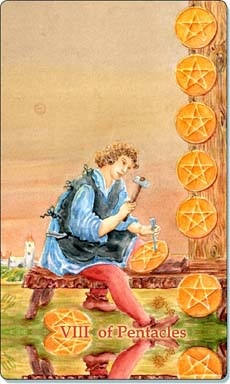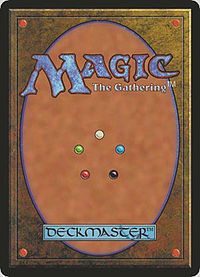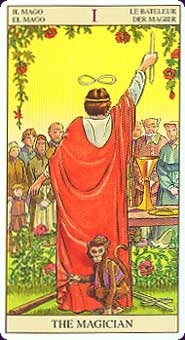 A lot of people look at Tarot as a way to go deeper into their own lives. That's what I do: helping people shed light on the patterns and energies in their lives, giving them a better look at where to go next. But what I love about the cards is they can be so versatile. Sometimes even a day-to-day question can get you strikingly specific results.
The time I couldn't get in touch with a friend, for instance, so I consulted the cards and drew The Moon (needless worry) and the Four of Wands (a celebration). She was at a festival that day, and couldn't get to her phone. Or this weekend, when my computer was being an absolute delight, and I hadn't heard from my tech support forum of choice for hours. The Magician told me I had the tools I needed to tackle it myself, and while I didn't fix everything, I did manage to get my Internet back online.
Of course, it's probably not always going to be effective if you rely on a deck of cards to tell you what to have for dinner tonight. But it makes for an interesting way to flex your reading muscles. Part of being an effective reader, after all, is letting your intuition stretch you just beyond the classic meanings of the cards into a new mode of thinking. (How would you use the cards to decide what's for dinner? Six of Cups means a favorite childhood meal? The Tower means something spicy with bold flavors?)
It's not good to let Tarot do all your thinking for you, of course, and it's an easy trap to start relying on it too much. Ultimately everything should rely on your own decisions and common sense. But give the Tarot a spin for an unusual question sometime, and see what muscles it flexes in your mind. It just might surprise you.
 You know how some people get brilliant flashes of inspiration in the shower? My completely un-brilliant flash went like this:
By all evidence, history shows us that Tarot originated in the mid-15th century as a card game called tarocchi. Each card in the Major Arcana represented a different rule that applied to the actual game. There's a lot of discussion about whether the Tarot also hid certain pagan ideas (unlikely, since earlier decks were very medieval Christian), or was used in teaching religious allegory to kids. But as far as history suggests, Tarot became used for divination because a lot of things are used for divination: tea leaves, entrails, playing cards (a method that pre-dates Tarot cards as a game or an oracle, I believe).
Now, this doesn't overturn Tarot's legitimacy one bit. First of all, Tarot spoke to people as a teaching tool and an oracle because it works with archetypes, very universal figures and ideas. The images were inspiring, and really that's all divination takes: taking a look at something as a lens through which you view your life and your future. You can divine using toothpicks, coins, or clouds, so long as you have a consistent meaning attached to them. The magic is in you and in the Universe. Tarot is just a very creatively inspiring tool, one that happened to link up very easily to a lot of pre-existing ideas, and became a very effective method for teaching them.
So effective, in fact, that Tarot's popularity as an oracle grew in the 1800s, when a man named Antoine Court de Gebelin was convinced that Tarot originated in Egypt and represented Egyptian mysteries. He wrote a paper alleging a lot of connections, and others picked up on it. (Scholarship was like that a lot, back then, and Egypt fever was alive and well.) And the idea that Tarot came from Egypt, and even Atlantis, survives to today.
Now, my grand revelation? Tarot started out as a card game with a series of characters that can alter the rules of what each player is allowed to do. And amazingly, we have card games like this all the time today, mainly in the form of trading cards. Pokemon has a card game similar to this, and an American version is Magic: The Gathering. And my absolute favorite weird bit of synchronicity? A card game from Japan called Yu-Gi-Oh, where the game's fictional mythos is that it was originally played in Egypt, commanding real magickal forces, and slowly evolved into a children's game years into the future.
In some ways, Tarot is a reverse-engineered Yu-Gi-Oh - a game my now-adult brother played a lot as a kid. When I informed him of this connection, he burst out laughing. And then, after a pause, he added: "History is weird."
I had to agree.
 There are hundreds of sites out there talking about how to read Tarot, and how each reader personally sees the cards. Personally, I love them all. They enhance my own insights and style, they make me a better reader.
But there's so much more the cards can do. Italo Calvino's book The Castle of Crossed Destinies has his characters unable to speak, telling their stories purely through Tarot images. The archetypes are so powerful, they can do a lot of speaking for us in the ways we least expect.
Here are five ways Tarot can be turned into a game or a creative tool.
- Cast your favorite characters into roles.
Think of your favorite piece of media - TV shows, movies, books. If they could fit into Tarot cards, who would they be? My nerdy little heart loves to do this with Disney characters, imagining Dumbo as the Fool, Bambi's mother as the Empress, and Doctor Facilier as a wicked, reversed version of The Magician.
- Create a storytelling Round Robin.
You can do this alone or in a group. It's a lot like campfire stories: after shuffling, one person draws a card, and says "There once was...a great and glorious hero, who drove a fearsome Chariot." (Just for an example.) Then the next card drawn continues the story: "One day this hero came across two children, giving each other gifts." See what comes out of the story you tell!
- Have an interview.
This is especially great to do if you're writing a book. Come up with a handful of questions for a character you're writing, and see what cards you draw for each question. Or reverse it - interview one of the Major Arcana about what they have to teach you, or their philosophy on life. You may be surprised at the new depths you find.
- Expand your vision.
One deck I need to get my hands on is the "Tarot of New Vision", a deck that takes familiar images from the Rider-Waite Tarot and turns them 180 degrees, so you can see a new perspective on the card. Imagine what's happening in the cards just offscreen, or behind the figure you see. Or look at one special detail in the cards, and zero in on it. How did the Magician receive his ouroboros sash? What's in the boats the figure in the Two of Wands is looking at? Write a journal entry or a story about it!
The best part of all this: while you use these games and story ideas to have fun, you're also learning to get closer to the cards, and be a better reader! See what new insights open up for you.
|



 RSS Feed
RSS Feed

